1.0 Introduction
Efficient state machine design using a Hardware
Description Language (HDL), such as Verilog, can
take many forms [1][2]. Are there specific forms
that lend themselves well to synthesis? This paper
describes some common coding styles and highlights
two coding styles with registered outputs that are
well suited for commonly used synthesis
techniques.
This paper will briefly describe coding styles
that generate combinational logic outputs and then
will detail coding styles that generate registered
outputs and describe why the registered output
coding styles are often beneficial to synthesis
strategies.
2.0 Basic FSM Structure
A typical block diagram for a Finite State
Machine (FSM) is shown in Figure 1.
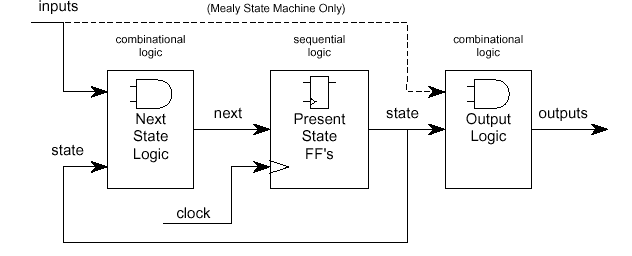
Figure 1 - FSM Block
Diagram
A Moore state machine is an FSM where the
outputs are only a function of the present state.
A Mealy state machine is an FSM where one or
more of the outputs are a function of the present
state and one or more of the inputs.
Both Moore and Mealy FSMs have been
successfully implemented in digital designs. How
the outputs are generated for these state machines
is an interesting topic. Outputs are sometimes
generated by combinational logic based on
comparisons with a set of states, and sometimes
outputs can be derived directly from individual
state bits.
The code in Example 1 uses a common, efficient
Verilog coding style to implement the state
diagram shown in Figure 2.
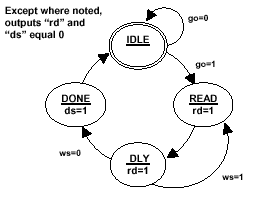
Figure 2 - FSM1 State
Diagram
This coding style is sometimes referred to as a
two-always block coding style with continuous
assignment outputs. The first always block in this
example is used to generate the sequential state
register, the second always block is used to
generate the combinational next state logic, and
the continuous assignments are used to generate
the combinational output logic.
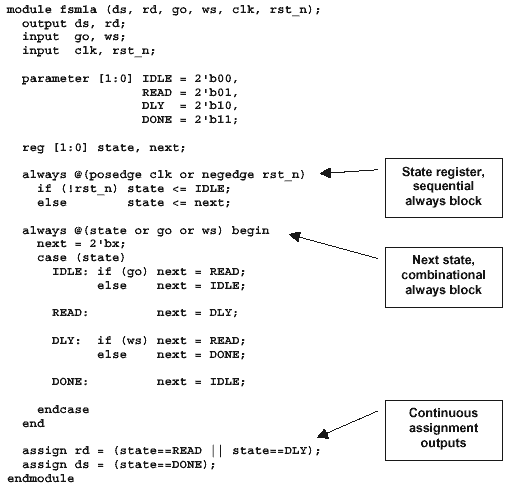
Example 1 - FSM Coding Style -
Two-always blocks with continuous assignment
outputs
The code in Example 2 is used to synthesize the
same basic logic as Example 1, but the generation
of the outputs is accomplished by moving the
output equations into the same always block that
is used to generate the combinational next state
logic. This is a commonly used two-always block
coding style.

Example 2 - FSM Coding Style -
Two-always blocks with combined output
assignments
The combinational outputs generated by these
two coding styles (Example 1 and Example 2) suffer
two principal disadvantages:
1. Combinational outputs can glitch between
states.
2. Combinational outputs consume part
of the overall clock cycle that would have been
available to the block of logic that is driven by
the FSM outputs.
When module outputs are generated using
combinational logic, there is less time for the
receiving module to pass signals through inputs
and additional combinational logic before they
must be clocked.
3.0 Partitioning For Synthesis
A popular and proven technique for partitioning
a design for synthesis is to partition the design
so that all outputs are registered and all
combinational logic is on the input-side of a
module as shown in Figure 3. This is sometimes
referred to as "cloud-register" partitioning.
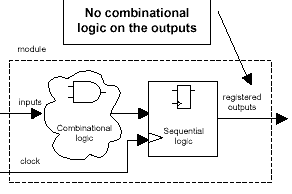
Figure 3 - "Cloud-register"
module partition
A variation on the same synthesis technique is
to partition the design so that all combinational
logic is on the inputs or between registered
stages within the module as shown in Figure 4.

Figure 4 - Multi-stage module
partition with registered outputs
The reason this technique is important is not
that it necessarily makes a design any better, but
that it greatly simplifies the task of
constraining a design for synthesis.
Designs can be and have been successfully
completed with combinational logic on both the
inputs and the outputs of module partitions, but
such designs complicate the task of constraining a
design to meet timing requirements.
As shown in Figure 5, if a design requires a
10ns clock cycle, and if the output combinational
logic of module A consumes 3.5ns, then the inputs
of modules C and D and some of the inputs of
module E must be constrained to use only 6.5ns
(including setup time on registered elements). If
module B consumes 5ns in the output combinational
logic, then the other inputs of module E must be
constrained to use only 5ns (including setup time
on registered elements).
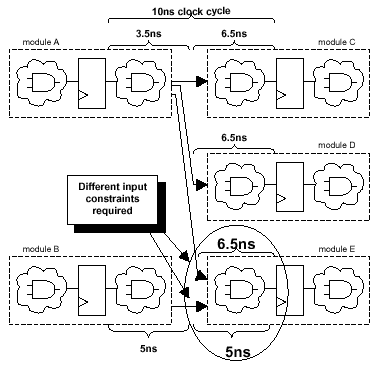
Figure 5 - Constraining
combinational outputs that drive combinational
inputs
For this simple 5-module design, the task of
making these constraints is not too difficult, but
imagine having to constrain dozens of inputs on
the tens or hundreds of modules of a larger
design, and making sure all of the constraints
have been correctly set. This is one of the
motivations behind registered module outputs.
4.0 Synthesis Time Budgeting
In a paper entitled "Evolvable Makefiles and
Scripts for Synthesis", [3] Ekstrandh and Bell,
describe a clever time-budgeting technique for
synthesizing many modules by constraining inputs
and outputs to sequential modules, and applying
time-budget allotments to pure combinational
modules. If pure combinational logic modules are
removed and all sequential module outputs are
registered, techniques similar to those described
by Ekstrandh and Bell become even easier to
implement.
One major argument against registered outputs
is that redundant combinational logic might be
required at the inputs of multiple receiving
modules. In contrast, moving the combinational
logic from some module outputs to the inputs of
receiving modules might help suggest a different,
more optimal partitioning of a design.
The best reason for moving combinational logic
away from module outputs is that it significantly
reduces synthesis scripting efforts that can lead
to more easily meeting overall timing constraints.
Tight constraints on output combinational logic in
a driving module and tight timing constraints on
input combinational logic in a receiving module
generally does not yield the same efficient logic
that could be inferred if all of the combinational
logic could be optimized together with a larger
overall timing constraint.
5.0 Registering FSM Outputs
Two good methods for coding FSMs so that all
module outputs are registered include, (1)
generating and registering "next-outputs", and (2)
Encoding the state variables so that each output
is one of the encoded bits of the registered state
variable.
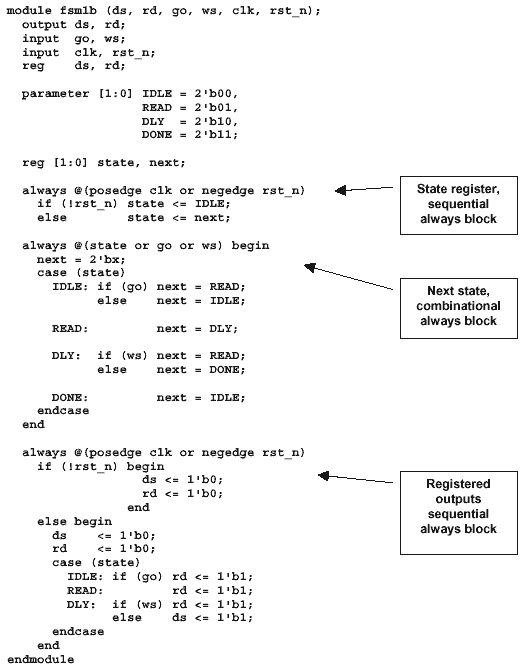
Example 3 - FSM Coding Style -
Three-always block coding style
5.1 Three Always Block FSM
The first method commonly used to register the
FSM outputs is to code a two always block FSM, the
same as in Example 1, but instead of generating
the outputs using continuous assignments, code a
third block as a sequential always block to
register the "next outputs" as shown in Example 3.
This method requires careful coding since this
style forces an engineer to examine the present
state and the inputs to determine what the "next
outputs" will be. This method is somewhat error
prone, but works fine if the outputs are properly
coded.
The block diagram in Figure 6 shows the two
sequential and one combinational logic blocks that
are generated by the three always blocks.
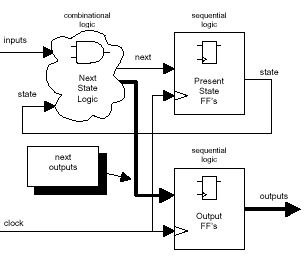
Figure 6 - FSM with registered
outputs
5.2 One-Hot Output Encoding
A second interesting method for registering the
FSM outputs is to select a state encoding that
forces the outputs to be driven by individual
state-register bits as shown in the block diagram
of Figure 7.
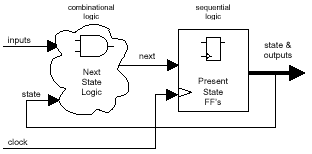
Figure 7 - FSM with registered
outputs encoded as state bits
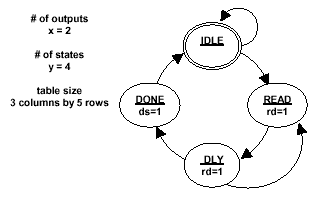
Figure 8 - Extracting table
information from a state diagram
A structured method for encoding the outputs as
part the state encoding is outlined in the
following steps:
1. Count the number of outputs (x) and the
number of states (y) in the state machine and
start by making a table with y+1 rows and x+1
columns.
2. Starting at the second row in the left-hand
column, make a list of all the FSM states, moving
down the column for each state in the state
machine. This will fill the left-hand column
except for the top left-hand column cell.
3. Starting at the first row, second column and
working to the right, list each FSM output as a
separate column header.

Table 1 - Starting state table
(redundant output patterns are circled)
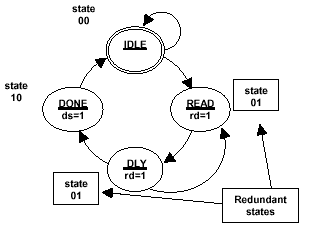
Figure 9 - One-hot output
encoded redundant states
4. Place a "1" in each output column where an
output is high for the listed states and place a
"0" in each output column where an output is low
for the listed states.
5. After filling out the entire table, search
for output patterns that are the same for more
than one state. If there are no duplicate
patterns, use the output patterns in the table as
state encodings. If all of the encodings are
unique, no additional state bits are necessary and
each state bit not only represents part of the
state encoding, it also represents what will
become a registered output bit.
Note: FSM inputs do not affect the state
encodings. Only the number of states and the
number of outputs affect the state encodings.
In general, the output patterns will not be
unique to any one state and the following
additional steps will be required:
6. Circle the duplicate output patterns in the
table as shown in Table 1.
7. If there are two output patterns that are
the same, one additional state bit will be
required to create unique state encodings. If
there are three or four output patterns that are
the same, two additional state bits will be
required to create unique state encodings. If
there are between five and eight output patterns
that are the same, three additional state bits
will be required to create unique state encodings,
etc.

Table 2 - State table after
adding extra state bit column
8. Add a blank column between the state names
column and the first output column and label this
column "x0." Add another column for each
additional required state bit, labeling each
column "x1", "x2", etc.
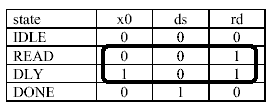
Table 3 - State table with
unique state encodings
Fill the added columns with all zeros except
for the circled redundant-encodings rows. Add
binary encodings into the extra columns of the
redundant-encoding rows to create unique state
encodings as shown in Figure 10.

Figure 10 - One-hot output
encodings with extra bits to create unique state
encodings
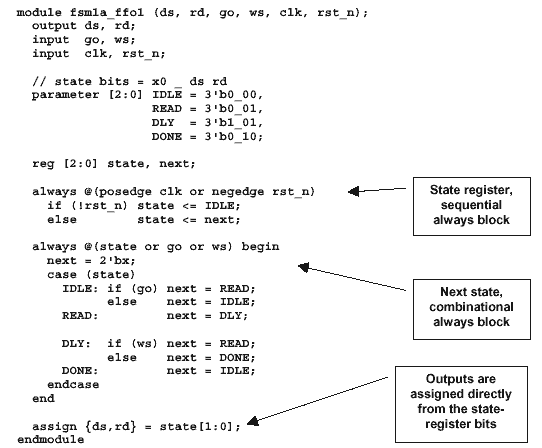
Example 4 - FSM Coding Style -
One-hot outputs encoding
The state encodings in Table 3 will now be used
to make Verilog parameter assignments to define
each state encoding.
Now that the outputs have been incorporated
into the state encodings, one or more continuous
assignment statements can directly drive the
outputs, where the actual state bits are used to
drive the outputs. Since no additional glue logic
is required to drive the outputs, the outputs will
now be glitch-free.
The outputs of the Verilog state machine are
now easily coded by making bit-select assignments
from the state vector to each output, or by
concatenating all of the outputs together into one
continuous assignment and assigning all of the
significant state bits to the outputs as shown in
Example 4. If extra state bits were required to
create unique state encodings, the output bits
will be the LSBs of the state vector.
6.0 Mealy Outputs
Asynchronous Mealy outputs violate the
synthesis guideline to partition a design into
"cloud-register" groupings. An asynchronous Mealy
output is an output that is a function of the
present state and one or more inputs, which
requires combinational logic to be placed on the
Mealy outputs, forming a cloud of combinational
logic after the register, as shown on the FSM
module in the block diagram of Figure 11.
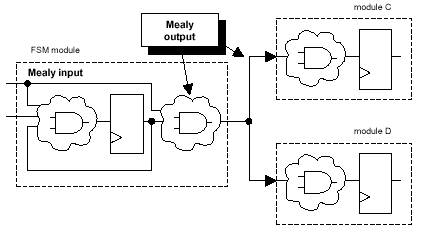
Figure 11 - FSM Mealy output
driving combinational inputs
It is frequently feasible to move asynchronous
Mealy outputs from an FSM module to the input or
inputs of one or more modules (such as modules C
and D as shown in Figure 12) that would have been
driven by the Mealy outputs.

Figure 12 - Mealy logic
partitioned separate from the FSM output
Transferring the Mealy logic from the output of
the FSM module to the inputs of the driven modules
might cause extra logic to be inferred because the
logic has to be taken from a single output-"cloud"
and added to potentially multiple input-"clouds."
The undesirable, small increase in area due to the
addition of redundant logic is generally offset by
significantly simplifying the design effort and
synthesis scripts.
7.0 Conclusions
- Partitioning designs so that there is no
combinational logic on the outputs of an FSM
significantly simplifies the task of
synthesizing a multi-module design.
- Coding FSMs with registered outputs
eliminates combinational output logic.
- Coding FSMs with registered outputs insures
that the outputs will be glitch-free.
- The one-hot output encoding style is an
efficient technique for coding FSMs to drive
registered outputs directly from the state
register bits.
References
[1] S. Golson, "State Machine Design Techniques
for Verilog and VHDL," Synopsys Journal of
High-Level Design, September 1994, pp. 1-48.
[2] C.E. Cummings, "State Machine Coding Styles
for Synthesis," SNUG (Synopsys Users Group) 1998
Proceedings, section-TB1 (3rd paper), March
1998.
[3] A. Ekstrandh, W. Bell, "Evolvable
Makefiles and Scripts for Synthesis," SNUG
(Synopsys Users Group) 1997 Proceedings,
section-C1 (2nd paper), February 1997.
